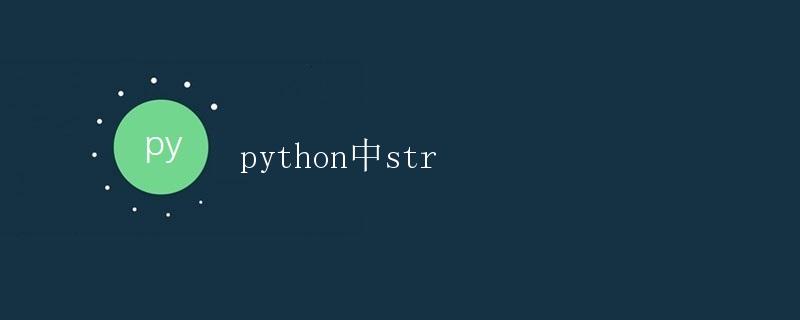Python中字符串

介绍
在Python中,字符串是一种常见的数据类型,用于表示文本数据。字符串是不可变的,可以包含字母、数字、特殊字符等。本文将详细介绍Python中字符串的基本概念、常用操作、字符串格式化以及一些常见问题。
字符串的创建
在Python中,我们可以使用单引号、双引号或三引号来创建字符串。
使用单引号创建字符串
str1 = 'This is a string.'
print(str1)
输出:
This is a string.
使用双引号创建字符串
str2 = "This is another string."
print(str2)
输出:
This is another string.
使用三引号创建字符串
如果字符串需要跨越多行,可以使用三引号:
str3 = '''This is a multi-line
string.'''
print(str3)
输出:
This is a multi-line
string.
需要注意的是,使用单引号或双引号创建的字符串中不能包含与引号相同的字符,但可以使用转义字符\来表示引号。
字符串的基本操作
Python为字符串提供了一系列常用的操作方法,例如连接、切片、替换等。
连接字符串
可以使用+运算符来连接两个字符串:
str1 = 'Hello'
str2 = 'World'
str3 = str1 + str2
print(str3)
输出:
HelloWorld
字符串切片
可以通过索引来访问字符串中的单个字符,Python中的索引从0开始计数。可以使用冒号来进行切片操作,str[start:end]会返回从索引start到end-1的子字符串。如果start和end都省略,则表示截取整个字符串。
str4 = 'Hello World'
print(str4[0]) # 输出第一个字符
print(str4[1:5]) # 输出第2到5个字符
print(str4[:5]) # 输出前5个字符
print(str4[6:]) # 输出第7个字符及以后的字符
输出:
H
ello
Hello
World
字符串长度
可以使用len()函数来计算字符串的长度:
str5 = 'Hello World'
print(len(str5))
输出:
11
字符串替换
可以使用replace()方法来替换字符串中的子串:
str6 = 'Hello, Python'
new_str = str6.replace('Python', 'World')
print(new_str)
输出:
Hello, World
字符串查找
可以使用find()方法来查找字符串中的子串,find()方法返回子串的索引值,如果找不到则返回-1。
str7 = 'Hello, World'
index1 = str7.find('World')
index2 = str7.find('Python')
print(index1)
print(index2)
输出:
7
-1
字符串分割
可以使用split()方法将字符串分割成多个子串,split()方法默认使用空格作为分隔符,也可以指定其他分隔符。
str8 = 'Hello, World'
split_str1 = str8.split()
split_str2 = str8.split(',')
print(split_str1)
print(split_str2)
输出:
['Hello,', 'World']
['Hello', ' World']
字符串大小写转换
可以使用lower()方法将字符串转换为小写,使用upper()方法将字符串转换为大写。
str9 = 'Hello, World'
lower_str = str9.lower()
upper_str = str9.upper()
print(lower_str)
print(upper_str)
输出:
hello, world
HELLO, WORLD
字符串格式化
字符串格式化是将变量插入到字符串中的一种常见操作。在Python中,有多种方式来进行字符串格式化,包括使用%占位符、使用format()方法和使用f-strings。
使用%占位符
可以使用%占位符来将变量插入到字符串中。%s表示字符串占位符,%d表示整数占位符,%f表示浮点数占位符。
name = 'Alice'
age = 25
height = 1.65
print('My name is %s, I am %d years old and %.2f meters tall.' % (name, age, height))
输出:
My name is Alice, I am 25 years old and 1.65 meters tall.
使用format()方法
可以使用format()方法来进行字符串格式化。{}表示占位符,可以在format()方法中传递参数填充占位符。也可以使用索引来指定要插入的变量。
name = 'Alice'
age = 25
height = 1.65
print('My name is {}, I am {} years old and {} meters tall.'.format(name, age, height))
print('My name is {0}, I am {1} years old and {2} meters tall.'.format(name, age, height))
输出:
My name is Alice, I am 25 years old and 1.65 meters tall.
My name is Alice, I am 25 years old and 1.65 meters tall.
使用f-strings
f-strings是Python 3.6及以上版本引入的新特性,使用f前缀来表示f-string。可以在字符串中使用花括号{}来插入变量。
name = 'Alice'
age = 25
height = 1.65
print(f'My name is {name}, I am {age} years old and {height} meters tall.')
输出:
My name is Alice, I am 25 years old and 1.65 meters tall.
常见问题解答
如何判断两个字符串是否相等?
可以使用==运算符来判断两个字符串是否相等:
str1 = 'Hello'
str2 = 'World'
if str1 == str2:
print('Two strings are equal.')
else:
print('Two strings are not equal.')
输出:
Two strings are not equal.
如何查找字符串中特定字符的出现次数?
可以使用count()方法来统计字符串中特定字符的出现次数:
str3 = 'Hello, World'
count = str3.count('o')
print(count)
输出:
2
如何判断字符串是否以特定字符开头或结尾?
可以使用startswith()方法判断字符串是否以特定字符开头,使用endswith()方法判断字符串是否以特定字符结尾:
str4 = 'Hello, World'
start = str4.startswith('Hello')
end = str4.endswith('World')
print(start)
print(end)
输出:
True
True
如何将字符串转换为整数或浮点数?
可以使用int()函数将字符串转换为整数,使用float()函数将字符串转换为浮点数。
num_str = '12345'
int_num = int(num_str)
float_num = float(num_str)
print(int_num)
print(float_num)
输出:
12345
12345.0
如何去除字符串中的空格?
可以使用strip()方法去除字符串中的空格。如果需要去除字符串左边的空格,可以使用lstrip()方法;如果需要去除字符串右边的空格,可以使用rstrip()方法。
str5 = ' Hello, World '
new_str = str5.strip()
print(new_str)
输出:
Hello, World
如何判断字符串是否由字母组成?
可以使用isalpha()方法判断字符串是否由字母组成,返回布尔值。
str6 = 'HelloWorld'
is_alpha = str6.isalpha()
print(is_alpha)
输出:
True
如何将字符串反转?
可以使用切片操作来将字符串反转。通过[::-1]可以逆序遍历字符串。
str7 = 'Hello, World'
reverse_str = str7[::-1]
print(reverse_str)
输出:
dlroW ,olleH
如何判断字符串是否全为小写或全为大写?
可以使用islower()方法判断字符串是否全为小写,使用isupper()方法判断字符串是否全为大写,两个方法都返回布尔值。
str8 = 'hello, world'
is_lower = str8.islower()
is_upper = str8.isupper()
print(is_lower)
print(is_upper)
输出:
True
False
总结
本文介绍了Python中字符串的基本概念、常用操作和字符串格式化方法。通过学习本文,您应该对字符串在Python中的常见使用场景有了基本的了解。
 极客教程
极客教程